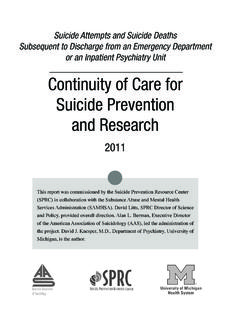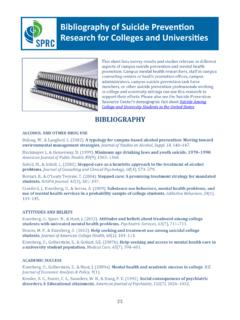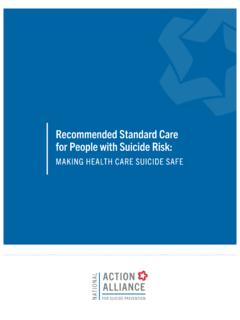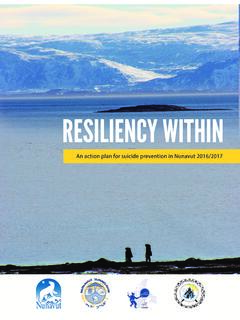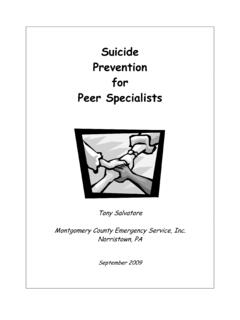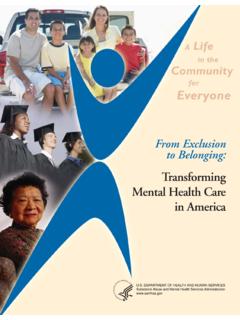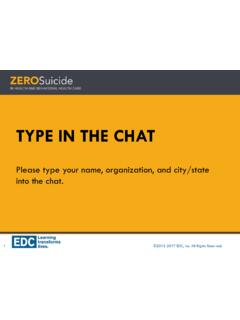Transcription of Transforming Conversations About Suicide - nmcdn.io
1 Transforming Conversations About SuicideA Study Conducted by the Youth Council for Suicide PreventionRobin Lindquist-Grantz, PhD, LISW-SRenae KochMargot BrunetteAmanda Drew31stAnnual research & Policy Conference on Child, Adolescent & Young Adult Behavioral Health | Tampa, Florida | 2018 Adolescent Suicide Overview 2ndleading cause of death for youth ages 10-24 (CDC, 2016) Recent years show a steady rise in suicidality since lowest rates in mid-2000s (CDC, 2016) Estimated 100-200 attempts for every 1 death by Suicide (Drapeau& McIntosh, 2015)Address full range of suicidal factorsExpand focus on protective factorsFurther develop coping, problem-solving, and help-seeking skillsComprehensive, collaborative strategies involving schools, healthcare, and mental healthIncreased communication around topic of suicideInnovative methods that empower youth and represent their lived experienceYouth Council for Suicide prevention (YCSP) Academic partners: Cincinnati Children s Hospital Medical Center Division of Emergency Medicine & University of Cincinnati Youth partners: 26 youth from 11 different schools during 2015-2016 cohort year Volunteer as co-researchers and advisors on Suicide screening and intervention in the pediatric emergency department 2015-2016 cohort: designed and conducted a qualitative interview project targeting peersYouth Participatory Action research (YPAR) Engages youth insider expertise (Ozer, 2016, p.)
2 266) in the examination of issues that affect them so they can take leadership in finding solutions for those issues (Cammarota& Fine, 2008; Rodr guez & Brown, 2009)..explicitly pedagogical with implications for education and youth development (Cammarota& Fine, 2008, p. 6)..contribute to creating health programs and services that can better meet the needs of young people while simultaneously expanding their knowledge and skills, therefore increasing their capacity to engage in more healthful decision making (Suleiman, Soleimanpour, & London, 2006, p. 126).Improve Rigor, Relevance & ReachSocial-ecological theory (Bronfenbrenner, 1979)+Positive youth development (Lerner, 2004; Silbereisen& Lerner, 2007) YPAR Framework for YCSPYCSP Qualitative StudyStudy Purpose:To explore the ways in which the topic of Suicide is perceived and addressed among youth in order to identify methods of communication that encourage Conversations About do youth view Suicide ?
3 Are youth perceptions of why people address Suicide the way that they do? are the key components of powerful and effective Conversations About Suicide ?Study Method Semi-structured interviews conducted by youth researchers Participants recruited from youth researcher schools and social networks Approximately 20-30 minutes Participatory group analysis during three 2-hour meetings 1stcycle: small groups; 3-4 people w/ 4-5 paper transcripts; independent coding (Vaughn & Lohmueller, 2014) 2ndcycle: small groups sorted independent codes into thematic categories; large group collapsed small group categories into overall themes (Kane & Trochim, 2007)Study Participants (n = 17) 65% Female; 35% Male 82% White/Caucasian 6% Hispanic 8 high schools (5 public, 3 private)Study FindingsTheme 1: Youth need help understanding Suicide Unless you ve had an experience with it, I don t think it s something that people think aboutvery much or understand very much.
4 I mean, obviously it doesn t make you feel happy to talk About it, so you kind of avoid it when you can. If it were in some sort of context like it is now [through the interview], or it came up in conversation, I would talk About it. But it s not exactly a conversation starter for me. Complicated and sensitive topic Important topic vs. emotionally complex Desire to discuss it more openly & frequentlyStudy FindingsTheme 2: The perceived reactions of others guides youth behavior Sometimes I m scared to open up to my mom because I feel like she s going to cry. Because she does that a lot, she breaks her back for me. And I m like, I don t wannaput you through that ..I would be afraid that they wouldn t trust me then or they d want to kind of protect me so much to the point that it became overbearing. I think it s very important that we have some type of plan in place and you can tell people that hey, this is what you do ..we need to let people know what to do, because I really don t know what s the right thing to do.
5 Eventually you probably have to involve some type of medical or counseling personnel, but at what stage do you involve that in? Reported they are likely to turn to people who seem open to discussing the topic in general Especially sensitive to parent reactions Friends viewed more positively, but ill-equipped to deal with the issueStudy FindingsTheme 3: Youth need help taking Suicide seriously Awkward topic to discuss Desire to discuss it more openly & frequently Lack of experience with the topic need more personal stories I m not sure. Maybe they don t have any experiencewith it so they don t understandthe full impact of Suicide on their family and friends. Where do I belong? When I hear Suicide , I picture all the kids saying, where do I belong? Where am I supposed to be in this world?How do I fit in this clique that clique? How can my teachers judge my religion or try to put me in their religion even if I m not? How can I fit in?
6 Study FindingsTheme 4: Youth prefer small groups May make youth more comfortable discussing the topic May contribute to greater depth of Conversations May develop greater trust among peers, and between youth and adults It is addressed as, you know, kindain a formal setting. Outside of the classroom I wouldn t say it s talked About a lot. We haven t really had any seminars or anything like that About it, but there is some talk About it. As far as Suicide prevention , I would say that there is definitely an effort but probably not good enough. I think you would also have to talk About it in a smaller group because there is [sic] a lot of people that aren t comfortable talking in a large group that would be comfortable talking in a small group. Study FindingsTheme 5: Supportive schools are essential Primary setting for youth Current efforts viewed as infrequent and lack help-seeking content Perception that school personnel do not care nor are willing to listen to them I m not really sure if [ Suicide has been addressed] at all this year.
7 But, you know, I m a freshman so I don t really know. They always do these weird talks where they try to explain it, but I don t really think they do it that well. If they were more open to us, then we would be more open to them. I think the admin [sic] is just afraidof addressing Conversations that aren t comfortable for people. Just because we go to a big school, the controversythat surrounds those topics, they re worried About the school being associated with bad just don t want to glorifysuicide. Study FindingsTheme 6: Social media as a prevention tool Suicide already being discussed, but youth struggle to navigate online Conversations Potential as far-reaching platform due to importance in youth culture Potential to reduce stigma and expand help-seeking behaviors ..it s like a post war,basically. And they always be like, the Suicide game at the s really serious to young kidsbecause, you know, there s been a lot of deaths lately [in the local school district].
8 People like it and comment at the bottom, but it s like they re not taking it seriously. They put laugh emojis. ImplicationsLocal ImplicationsImplications for Suicide prevention FieldYCSP Vision Statement: The lack of education About Suicide at school leads to people not understanding Suicide and feeling like there is a lack of social support. To prevent Suicide , we need to address concerns About how others react, target social media, and make use of small groups. New website Expand social media presence New video with updated personal stories School presentation & future creating workshop Community awareness event & fundraiser New partnership with 1N5 Expand communication openness and frequency (general & specific concern) Expand Conversations in school settings Help youth apply knowledge with peers and adults over time as they experience new situations and emotions Emphasize social connectedness Incorporate small group settings Potential theoretical frameworks: Relational Theory & Experiential Learning TheoryReferencesBronfenbrenner, U.
9 (1979). The ecology of human development: Experiments by nature and , MA: Harvard University , J., & Fine, M. (2008). Youth participatory action research : A pedagogy for transformational resistance. In J. Cammarota, & M. Fine (Eds.), Revolutionizing education: Youth participatory action research in motion(pp. 1-11). New York, NY: Routledge. Centers for Disease Control NCfIPaC, National Vital Statistics System, National Center for Health Statistics (2016). 10 Leading Causes of Death by Age Group, United States 2014 [reviewed 2016 August 15]. Retrieved from , C. W., & McIntosh, J. L., (2015). Suicide 2014: Official final data. Washington, DC: American Association of Suicidology. Retrieved from , M., & Trochim, W. (2007). Concept mapping for planning and Oaks, , R. M. (2004). Liberty: Thriving and civic engagement among America s youth. Thousand Oaks, CA: , E. J. (2016). Youth-led participatory action research . In L. A.
10 Jason & D. S. Glenwick(Eds.), Handbook of methodological approaches to community-based research : Qualitative, quantitative, and mixed methods(pp. 263-272). New York, NY: Oxford. Rodr guez, L. F., & Brown, T. M. (2009). From voice to agency: Guiding principles for participatory action research with youth. In T. M. Brown & L. F. Rodriguez (Eds.), New directions for youth development, (pp. 19-34). San Francisco, CA: , R. K., & Lerner, R. M. (2007). Approaches to positive youth development: A view of the issues. In R. K. Silbereisen, & R. M. Lerner (Eds.), Approaches to positive youth development(pp. 3-30). Suleiman, A. B., Soleimanpour, S., & London, J. (2006). Youth action for health through youth-led research . Journal of Community Practice, 14(1-2), 125-145. Vaughn, L. M., & Lohmueller, (2014). Calling all stakeholders: Group Level Assessment (GLA) a qualitative and participatory method for large groups. Evaluation Review: A Journal of Applied Social research 38(4): 336-335.




